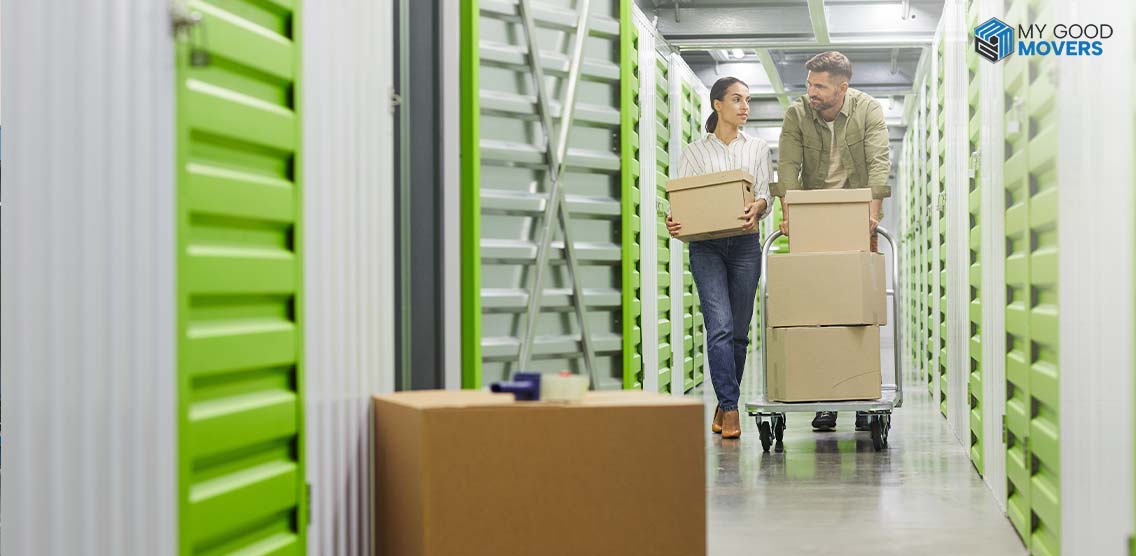You have got some stuff that needs storing, and you're staring at a list of storage unit sizes, wondering, "What size storage unit do I need?" It's a common dilemma, and you're not alone.
But don’t worry—there are some steps that will help you find the right storage unit for your needs. By the end of this, you'll feel confident in your decision and have a clear understanding of storage unit sizes and prices so you can make the best choice possible.
Storage Unit Sizes - The Basics
Before we get into specifics, let’s start with a storage unit size guide. Storage units come in various sizes, usually ranging from 5x5 feet (25 square feet) to 10x30 feet (300 square feet) or larger. The size you choose depends on what you need to store, so it’s important to have a clear inventory of your items.
Let’s break down some common sizes:
- 5x5 (25 sq. ft.): Think of it as a walk-in closet. This size is great for storing small furniture, boxes, seasonal decorations, or personal items.
- 5x10 (50 sq. ft.): About the size of a large walk-in closet, this unit can hold items from a small one-bedroom apartment—think a bed, dresser, and a few boxes.
- 10x10 (100 sq. ft.): Now we are getting into small apartment territory. This size can handle the contents of a one-bedroom apartment, including appliances, furniture, and boxes.
- 10x15 (150 sq. ft.): This unit is perfect for a two-bedroom apartment or a small house. It can accommodate larger furniture like couches, tables, and even some larger appliances.
- 10x20 (200 sq. ft.): Moving into a three-bedroom house? This size can store the contents of a larger home, including multiple beds, a dining table, couches, and large appliances.
- 10x30 (300 sq. ft.): The biggest standard size, this unit is practically a small warehouse. It can hold a four-bedroom house’s worth of belongings or even a car with room to spare.
Now that you have an idea of what’s out there, it’s time to determine the storage unit size that best suits your specific needs.
Related articles that can help you understand further.
- How to Utilize a 5x15 Storage Unit
- What Can You Fit in a 5x10 Storage Unit?
- What Can a 5x5 Storage Unit Hold?
- Can You Use Container as a Storage Unit?
How to Determine Storage Unit Size
How do you figure out what size you actually need? Here’s a simple, step-by-step approach:
- Take Inventory: Write down everything you plan to store. It helps to categorize items—furniture, boxes, appliances, etc. This will give you a clear picture of what you are dealing with.
- Consider Accessibility: Are you going to need frequent access to your items, or will they be in storage long-term? If you will be accessing things regularly, you might want to go up a size to allow for easy movement within the unit.
- Use a Storage Unit Size Calculator: Many storage companies offer online storage unit size calculators. These tools allow you to input the items you plan to store and will suggest a suitable unit size. This is a super handy way to compare storage unit sizes without guesswork.
- Visit the Facility: If possible, visit the storage facility. Seeing the units in person can give you a better idea of the space available, especially if you are torn between small vs large storage units.
- Ask for Expert Advice: Don’t hesitate to ask the staff at the storage facility for recommendations. They deal with storage unit sizing every day and can offer insights you might not have considered.
Storage Unit Sizes: Small vs. Large
What is the difference between small vs large storage units? Sometimes, you might think you need a larger unit when a smaller one would suffice—or vice versa.
Here are a few considerations:
- Small Storage Units (5x5, 5x10): These are ideal for storing seasonal items, a few pieces of furniture, or the contents of a small room. They’re budget-friendly and perfect if you don’t have a lot to store or if you’re looking to declutter your home.
- Large Storage Units (10x20, 10x30): Large units are best if you are storing the contents of a multi-bedroom home, a vehicle, or a combination of large items. They are more expensive but offer the space you need to avoid cramming and damaging your belongings.

One thing to keep in mind is that it's better to go slightly larger than you think you'll need. You don't want to be stuck playing Tetris with your belongings only to realize they won't all fit.
Storage Unit Size Tips - Making the Most of Your Space
Let’s get into some storage unit size tips to ensure you’re maximizing your space:
Curious about your moving costs? Fill out the details, and we’ll calculate them for you.

- Disassemble Furniture: Break down tables, bed frames, and other large items to save space.
- Use Vertical Space: Stack boxes and items carefully, placing heavier items on the bottom and lighter ones on top.
- Store Smartly: Place items you might need to access frequently near the front of the unit.
- Label Everything: Label your boxes so you can find what you need without digging through everything.
- Use Uniform Boxes: If possible, use boxes of the same size. This makes stacking easier and more efficient.
Storage Unit Sizes and Prices: What to Expect
When it comes to storage units, size isn’t the only factor to consider—cost is just as important. Storage unit sizes and prices can vary widely depending on factors such as location, amenities, and the duration of the rental. Understanding these variables can help you budget more effectively and avoid unexpected expenses.
Below is a detailed table outlining average monthly costs for storage units across various sizes, locations, and types in the U.S.
| Unit Size | Type of Unit | Urban Area | Suburban Area | Rural Area | Climate-Controlled | Drive-Up Access | Insurance | Admin Fee | Deposit |
|---|---|---|---|---|---|---|---|---|---|
| 5x5 (25 sq. ft.) | Indoor, Standard | $70-$120 | $50-$80 | $40-$60 | +20-50% | N/A | $10-$15 | $15-$25 | $0-$50 |
| 5x10 (50 sq. ft.) | Indoor, Standard | $90-$150 | $60-$100 | $50-$80 | +20-50% | +$10-$20 | $10-$15 | $15-$25 | $0-$50 |
| 10x10 (100 sq. ft.) | Indoor, Standard | $130-$200 | $100-$150 | $80-$120 | +20-50% | +$10-$20 | $15-$25 | $15-$25 | $0-$100 |
| 10x15 (150 sq. ft.) | Indoor, Standard | $150-$250 | $120-$180 | $100-$150 | +20-50% | +$15-$25 | $15-$25 | $15-$25 | $0-$100 |
| 10x20 (200 sq. ft.) | Indoor, Standard | $200-$350 | $150-$250 | $130-$200 | +20-50% | +$20-$30 | $20-$30 | $15-$25 | $0-$150 |
| 10x30 (300 sq. ft.) | Indoor, Standard | $250-$450 | $200-$300 | $180-$250 | +20-50% | +$25-$40 | $20-$30 | $15-$25 | $0-$150 |
| 10x30 (300 sq. ft.) | Drive-Up, Outdoor | $300-$500 | $220-$350 | $200-$300 | N/A | Standard | $20-$30 | $15-$25 | $0-$150 |
| 10x20 (200 sq. ft.) | Climate-Controlled, Indoor | $250-$400 | $200-$300 | $150-$250 | Standard | N/A | $20-$30 | $15-$25 | $0-$150 |
Note: These prices can fluctuate based on location. Always check local prices by searching for storage unit sizes near me to get the most accurate information.

Most storage units are around eight feet tall, so if 6′9″ LeBron James were to stand inside, he'd have just over a foot of space between his head and the ceiling.
Factors That Influence Storage Unit Prices
Location:
- Urban vs. Rural: Storage units in densely populated urban areas tend to be more expensive due to higher demand and real estate costs. Conversely, rural locations generally offer more affordable options.
- Regional Differences: The cost of living in certain regions, such as the West Coast or Northeast, can drive up storage unit prices. Areas like California, New York, or Washington, D.C., are typically more expensive than the Midwest or Southern states.
Unit Size:
- Small Units (5x5, 5x10): These are the most affordable options, suitable for storing a few pieces of furniture or boxes. They’re perfect for short-term storage or decluttering.
- Medium Units (10x10, 10x15): These units can store the contents of a small apartment or house. The cost is moderate but provides more flexibility for different storage needs.
- Large Units (10x20, 10x30): These units are designed for storing the contents of a large home or multiple vehicles. They come with a higher price tag but offer substantial space.
Type of Unit:
- Climate-Controlled Units: These units maintain a stable temperature and humidity level, which is ideal for sensitive items like electronics, artwork, or documents. Expect to pay 20-50% more for climate control.
- Drive-Up Units: Convenient for loading and unloading, these units are often more expensive than indoor units but offer ease of access, especially for heavy or bulky items.
- Indoor vs. Outdoor Units: Indoor units offer added security and protection from the elements, generally at a higher cost. Outdoor units are more affordable but might be less secure.
Additional Fees:
- Administration Fees: Many facilities charge a one-time setup fee, typically ranging from $15 to $25.
- Security Deposits: Some storage providers require a refundable security deposit, usually equivalent to one month’s rent.
- Insurance: It’s often mandatory to have insurance on your stored items, either through the facility or your own provider. This can add $10 to $30 per month.
- Late Fees: If you miss a payment, you will be charged late fees, which can range from $10 to $50, depending on the facility.
Duration of Rental:
- Short-Term vs. Long-Term: Short-term rentals (month-to-month) tend to be more expensive per month than long-term leases, where discounts or locked-in rates might be offered.
- Prepayment Discounts: Some facilities offer discounts if you pay for several months or a year in advance.





